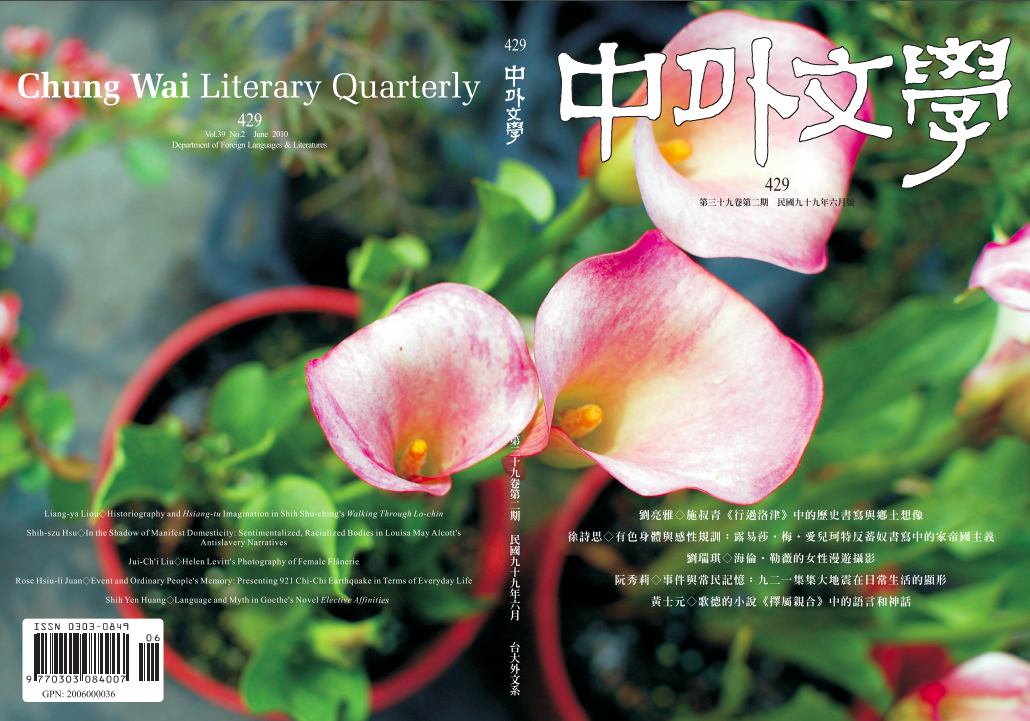第三十九卷 第二期 總429 中華民國99年6月
Vol.39 No.2 June 2010

《中外文學》六月號收錄五篇精彩論文:劉亮雅從歷史書寫和鄉土想像的角度閱讀施叔青的《行過洛津》,並以「對位」和「奇觀化」之概念進行詳盡剖析;徐詩思分析美國新英格蘭白人女作家愛兒珂特(Louisa May Alcott)的三篇反蓄奴故事,探討十九世紀白人家居女性的感性規訓計畫,及其種族歧視暨帝國主義面向;劉瑞琪以當代紐約攝影家海倫‧勒薇(Helen Levitt)的作品為個案,試圖由女性漫遊者的角度,探索現代街頭與地鐵攝影;阮秀莉針對九二一集集大地震後的文化生產(紀錄片、動畫、裝置藝術)進行文本分析,探索九二一地震事件在庶民日常生活中的顯形;黃士元則以班雅明專文〈歌德的《擇屬親合》〉中的理論基礎,探討歌德小說《擇屬親合》中的語言和神話問題。
中外文學六月號目錄
Contents
劉亮雅╱施叔青《行過洛津》中的歷史書寫與鄉土想像
施叔青《行過洛津》中的歷史書寫與鄉土想像
劉亮雅*
摘要
◎關鍵詞:《行過洛津》,歷史書寫,鄉土想像,性別政治
★國立臺灣大學外國語文學系教授。
Liang-ya Liou╱Historiography and Hsiang-tu Imagination in Shih Shu-ching’s Walking Through Lo-chin
Historiography and Hsiang-tu Imagination in Shih Shu-ching’s Walking Through Lo-chin
Liang-ya Liou*
Abstract
◎Keywords: Walking Through Lo-chin, historiography, hsiang-tu imagination, sexual politics
★Professor, Department of Foreign Languages and Literatures, National Taiwan University.
徐詩思╱有色身體與感性規訓: 露易莎‧梅‧愛兒珂特反蓄奴書寫中的家帝國主義
有色身體與感性規訓
露易莎‧梅‧愛兒珂特反蓄奴書寫中的家帝國主義
徐詩思*
摘要
◎關鍵詞:愛兒珂特,十九世紀美國文學與文化,反蓄奴書寫,家帝國主義,親密規訓,跨種族之愛,白人家居女性,感性主義與感官主義
★國立交通大學外國語文學系助理教授。
Shih-szu Hsu╱In the Shadow of Manifest Domesticity: Sentimentalized, Racialized Bodies in Louisa May Alcott’s Antislavery Narratives
In the Shadow of Manifest Domesticity
Sentimentalized, Racialized Bodies in Louisa May Alcott’s Antislavery Narratives
Shih-szu Hsu*
Abstract
◎Keywords: Louisa May Alcott, Nineteenth-Century U.S. Literatures and Cultures, Antislavery Narratives, Manifest Domesticity, Disciplinary Intimacy, Interracial Love, Domestic White Women, Sentimentalism and Sensationalism
★ Assistant Professor, Department of Foreign Languages and Literatures, National Chiao Tung University.
劉瑞琪╱海倫.勒薇的女性漫遊攝影
海倫.勒薇的女性漫遊攝影
劉瑞琪*
摘要
◎關鍵詞:海倫‧勒薇,布烈松,艾文斯,街頭攝影,地鐵攝影,女性漫遊者,女性主義
★國立陽明大學人文與社會科學院院聘副教授。
Jui-Ch’i Liu╱Helen Levitt’s Photography of Female Flânerie
Helen Levitt’s Photography of Female Flânerie
Jui-Ch’i Liu*
Abstract
◎Keywords: Helen Levitt, Henri Cartier-Bresson, Walker Evans, street photography, subway photography, flâneuse, feminism
★Associate Professor, School of Humanities and Social Sciences, National Yang-Ming University.
阮秀莉╱事件與常民記憶: 九二一集集大地震在日常生活的顯形
事件與常民記憶
九二一集集大地震在日常生活的顯形
阮秀莉*
摘要
◎關鍵詞:九二一地震,紀錄片,創作,事件,小敘述,日常生活
★國立中興大學外國語文學系教授兼系主任。
Rose Hsiu-li Juan╱Event and Ordinary People’s Memory: Presenting 921 Chi-Chi Earthquake in Terms of Everyday Life
Event and Ordinary People’s Memory
Presenting 921 Chi-Chi Earthquake in Terms of Everyday Life
Rose Hsiu-li Juan*
Abstract
◎Keywords: 921 Chi-Chi Earthquake, documentary film, creative work, event, small narrative, everyday life
★Professor and Chair, Department of Foreign Languages and Literatures, National Chung Hsing University.
黃士元╱歌德的小說《擇屬親合》中的語言和神話
歌德的小說《擇屬親合》中的語言和神話
黃士元*
摘要
◎關鍵詞:歌德,班雅明,小說,語言,神話,命運
★文藻外語學院德文系助理教授。
Shih Yen Huang╱Language and Myth in Goethe’s Novel Elective Affinities
Language and Myth in Goethe’s Novel Elective Affinities
Shih Yen Huang*
Abstract
◎Keywords: Johann Wolfgang von Goethe, Walter Benjamin, Novel, Language, Myth, Destiny
★Assistant Professor, Department of German, Wenzao Ursuline College of Languages.


